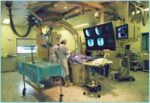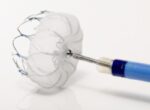Original title: Emergent cardiac surgery during transcatheter aortic valve implantation (TAVI): insight from Edwards SAPIENS Aortic Bioprótesis European Outcome (SOURCE) registry Reference: Holger Eggebrecht, et; al. Eurointervention 2013; 9online publish-ahead of print november 2013 Percutaneous aortic valve implantation has grown significantly since its inception, to be a safe procedure. The need for emergency cardiac surgery is rare, its<a href="https://solaci.org/en/2013/12/04/n-4124/" title="Read more" >...</a>
Post PCI bleeding can cause kidney injury
Original title: Impact of Periprocedural Bleeding on Incidente of Constrast-Induced Acute Kidney Injury in patients treated with Percutaneous Coronary Intervention. Reference: Yohei Ohno, et al. J Am Coll Cardiol 2013;62:1260-6 Contrast induced acute kidney injury (CI-AKI) is a serious complication associated to higher morbimortality rates and higher costs, but its correlation to bleeding remains controversial. This study included<a href="https://solaci.org/en/2013/10/03/n-3690/" title="Read more" >...</a>
Post TAVI Hypertension is a predictor of better evolution
Original title: Post-Procedural Hypertension Following Transcatheter Aortic Valve Implantation Incidence and Clinical Significance. Reference: Gidon Y. Perlman et al. J Am Coll Cardiol Intv 2013. Article in press. Pre-procedural hypertension (HTN) is a risk factor and a predictor of increased mortality after surgical aortic valve replacement (AVR). The disappearance of the pressure gradient across the aortic valve following<a href="https://solaci.org/en/2013/05/02/n-2689/" title="Read more" >...</a>
Valve-in-Valve Implantation Is Possible
Original title: 5 Years Experience With Trancatheter Tranaspical Mitral Valve –in Valve Implantation for Bioprosthetic Valve Dysfunction Reference: Anson Cheung et al. J Am Coll Cardiol 2013;61:1759–66. Percutaneous valves development, first aortic and now mitral, has brought an opportunity to improve life quality and extend life for high risk non-surgical patients. 23 patients received transapical implantation in mitral<a href="https://solaci.org/en/2013/04/29/n-2913/" title="Read more" >...</a>
First results of bioabsorbable metal scaffolds DREAMS
Original title: Safety and performance of the drug-eluting absorbable metal scaffold (DREAMS) in patients with de-novo coronary lesions: 12 month results of the prospective, multicentre, first-in-man BIOSOLVE-I trial. Reference: Michael Haude et al. Lancet 2013; 381: 836–44. Bioabsorbable scaffolds could improve vasomotion, remodelling and facilitate new interventions, both percutaneous and surgical. This new bioabsorbable scaffold, different from the<a href="https://solaci.org/en/2013/04/18/n-2871/" title="Read more" >...</a>
Appendage trans-catheter closure is equivalent to anticoagulation in fibrillated patients.
Original title: Percutaneous Left Atrial Appendage Closure for Stroke Prophylaxis in Patients With Atrial Fibrillation: 2.3-Year Follow-up of the PROTECT AF (Watchman Left Atrial Appendage System for Embolic Protection in Patients With Atrial Fibrillation) Trial. Reference: Vivek Y. Reddy et al. Circulation. 2013;127:720-729. Atrial fibrillation is the most common sustained arrhythmia in the world and its importance lies<a href="https://solaci.org/en/2013/03/01/n-2927/" title="Read more" >...</a>
Balloon Pulmonary Angioplasty (BPA) in patients with Chronic Thromboembolic Pulmonary Hypertension
Original title: Refined Balloon Pulmonary Angioplasty for Inoperable Patients with Chronic Thromboembolic Pulmonary Hypertension. Reference: Hiroki Mizoguchi et al. Circ Cardiovasc Interv. 2012;5:748-755. Patients with Chronic Thromboembolic Pulmonary Hypertension (CTE-PH) have bad prognosis. Pulmonary thromboendarterectomy can significantly reduce pulmonary pressure but, due to comorbidity or technical matters (very peripheral thrombi), not all patients are good candidates for this<a href="https://solaci.org/en/2013/01/11/n-3179/" title="Read more" >...</a>
Complex angioplasty with ventricular assist
Original title: Real-Word of the Impella 2.5 Circulatory Support System in Complex High-Risk Percutaneous Coronary Intervention: The USpella Registry Reference: Brijeshwar maini, et al. Catheterization and Cardiovscular Intervention For about a decade angioplasty has begun to be performed in increasingly complex patients (PE) such as those with left coronary trunk injury, 3-vessel injury, poor ventricular function and surgically<a href="https://solaci.org/en/2012/11/29/n-3830/" title="Read more" >...</a>
Aortic Transfemoral Valve Replacement using Edwards SAPIEN and Edwards SAPIEN XT Prosthesis, Local Anesthesia.
Reference: Durand E. et al (JACC CV interventions 2012 in press)1 When percutaneous aortic valve replacement (AVR) first began the procedure required a large-bore sheath (22-24 F), being the most frequent surgical strategy when using general anesthesia. Continuous technological advances achieved the miniaturization of devices which allow the procedure to be performed with a much<a href="https://solaci.org/en/2012/10/01/n-3914/" title="Read more" >...</a>






